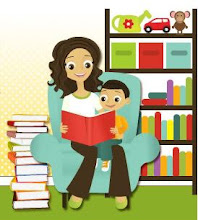- Don’t compare boys to girls – boys take longer to develop language and literacy skills. And comparing boys to girls is just unfair. What's "on target" for girls is not the same as what's "on target" for girls. Here's an example: if you have a boy that can write the letter A in shaving cream, but is reluctant to pick up a pencil to write, is it really fair to say that this child "can't" writ the letter A. Well he can write it...maybe he needs more fine motor activities to help him with his pencil skills, but it's not fair to say flat-out that this child can't write the letter A.
- Evaluate your own teaching style – do you expect boys to adapt to you or are you adapting your teaching style to meet their needs? Is your circle time too long to really grasp the attention of the boys AND the girls in your room? Are you providing activities that meet the needs of all kinds of learners (visual, active, auditory, etc)?
- Do you have books and writing materials in ALL areas of the classroom? If the boys in your room rarely choose to go to the library or writing table, then they are missing potential learning opportunities. In order to overcome this challenge, encourage reading and writing in all areas: in block area, add construction and architecture books as well and pencils and paper for making signs; at the work bench, add paper and pencils for making "blueprints;" in the science area, include encyclopedias, nature books, and science-related diagrams. Be creative, but make sure that reading and writing opportunities are all around.
- Have male role models read to your class. In most child care programs, men are few and far between. So look to your parents or other members of the community to read stories to the classroom.
- When you do author studies, purposely ensure to feature as many male authors as you do female authors.
- Be sure that you have books that cater to the interests of the boys in your classroom.
- Visit websites such as Getting Boys to Read and Guys Read to learn new and exciting ways to engage the boys in your classroom. Another helpful site is Reading is for the Boys...it's a webquest geared for K-12 teachers but many of the information is helpful and can be adapted to the younger ages.
Books About Boys and Books



























I completely agree with your tips above and can't underscore enough the importance of having engaging literature that captivates our boys in our classrooms. I find that I include a list in my newsletters to parents as its a frequent question I get - what series to recommend to boys? Now, five years into the job, I find that I often put my literary choices through that filter - will this hold the interest of ALL my students? If not, will we be better off doing lit circles or book club groups? I am careful not to gender certain genres, or make it seem odd if a boy in class WANTS to read the "Dear Canada" diary series that presents a Canadian girl's perspective, but I ask myself if there are noble characters for both boys and girls.
ReplyDeleteOne of my profs in university said "What are you doing with the non-renewable life minutes of your students?" and taught me the value of each moment. I don't have time for bad literature in my classroom!
Another terrific resource is "Best Books for Boys" by Matthew D. Zbaracki. This guide offers an extensive annotated bibliography of books that will appeal to a wide age range, and many different interests.
ReplyDeleteCheryl - Thanks for your perspective. I love that question: What are you doing with the non-renewable life minutes of your students? I guess we can all ask ourselves that question!
ReplyDeleteHi Jenn!
ReplyDeleteThanks for your comment. I do have that book in a post scheduled for tomorrow :-)